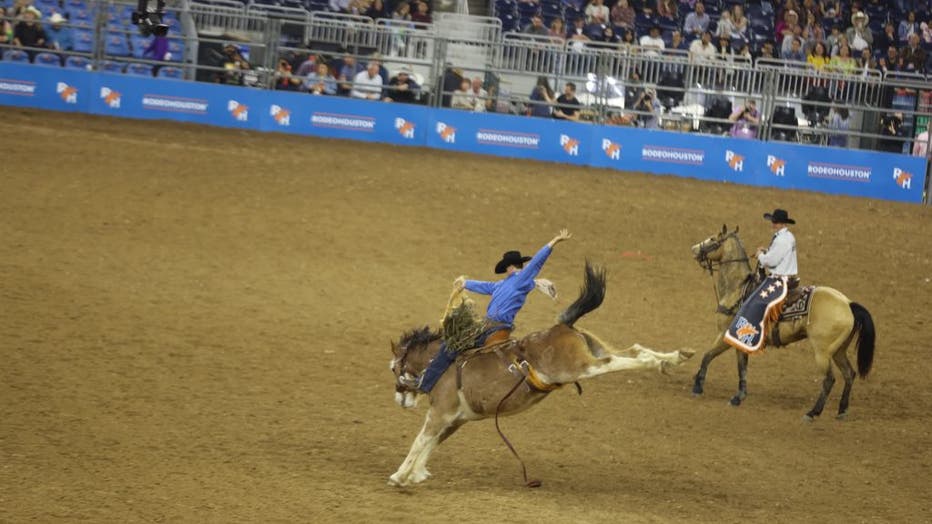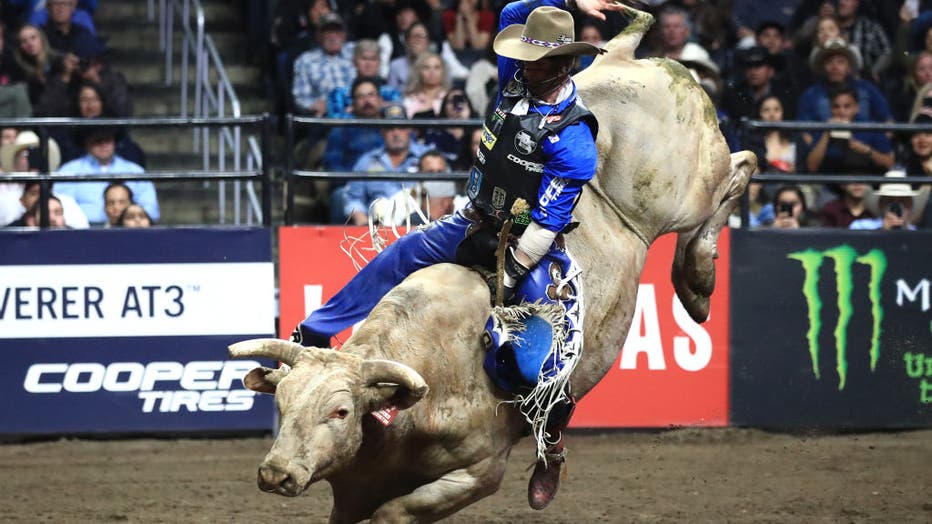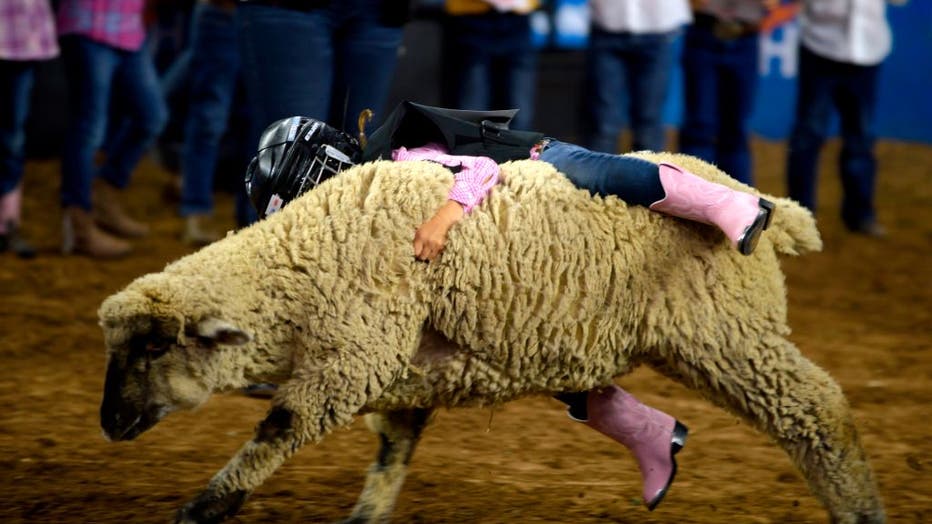Houston Rodeo: Rodeo 101 for newcomers, what to know about Rodeo events
HOUSTON - This ain't my first rodeo! Or is it? If it is, don't worry because we're about to help give you a quick crash course on everything rodeo.
The Houston Livestock Show and Rodeo is the event of the year for Houstonians and the Rodeo itself is an official sport in Texas.
There are different events you can watch that are all action-packed and will leave you wanting to yell out "yee-haw!"
Here are the basics for each Houston Rodeo event to help you know a little bit more about what you're getting into.
RODEO TICKETS: Here's how to get tickets, passes for Houston Livestock Show & Rodeo 2023
Tie-Down Roping
Tie-down roping is inspired by the traditional method cowboys would gather cattle. The event is timed and requires the horse and rider to be in sync to catch and tie down the runaway calf.
The calf will reach a certain distance after being given a head start and will trip a lever releasing the barrier on the roping box. The rider and horse will take off in pursuit of the calf.
The cowboy has to swing the rope over his head and launch it forward around the calf's neck. The horse will then come to a halt, so the rider can dismount and run after the calf Once it reaches the calf, the cowboy will quickly flip it over and begin to tie down any three of the calf legs. Once the calf is tied up, the roper throws his hands in the air to stop the clock.
A 10-second penalty is added if the horse and his rider break the barrier. In order for the cowboy's time to be recorded, the calf has to stay tied for an official three seconds starting from the roper's first step away from the calf. If the rope comes undone during that time, the team will receive a no-time.
2023 Houston Livestock Show & Rodeo kicks off
Rodeo season has officially arrived. CEO & President Chris Boleman drops by to talk about the exciting event.
Bareback Riding
Bareback riding is described as the most physically demanding rodeo event, as it tests the cowboy's strength and ability to hang on without any equipment. The rider has to rely on his technique and training to make it past eight seconds.
In order to have a successful ride, the cowboy must have an appropriate mount in the chute. The rider then must keep his front legs above the horse's shoulders before its front hooves hit the arena dirt on the front jump while lying flat on the horse's back.
When the gate opens, the rider must keep one hand on the rigging, which is the leather strap behind the horses' front legs, while the freehand is in the air. If the rider's free hand touches his body, the rigging, or the horse at any point during their ride then the rider is disqualified.
The cowboy and the horse are both judges for this event. For the ride, the cowboy should keep spurring in rhythm with the horse's bucking action. This will help the rider maintain stability and proper form. If the horse fails, to buck or performs poorly, the rider may be offered to re-ride on a different horse, selected by the stock contractors before every performance.
2023 Houston Rodeo fashion trends
Need some fashion inspiration for this year's rodeo? We have you covered!
Team Roping
Team roping is the only event that allows cowboys to work together in the arena. In this timed event, anything can happen when the steer is released from the chute so teamwork and trust are important.
The first roper is also called the header and is placed to the left of the steer with the second roper, or the heeler, to the right of the steer. When the header leaves the roping box, he must first rope the steer around the horns. After that, the heeler must then throw his rope around the steer's back legs. If the header misses, the team receives a no-score.
If the header catches, he must loop his rope around the saddle horn, turning the steer for the heeler to catch. If the heeler only catches one leg the team will be penalized five seconds. They will also be penalized if the header breaks the barrier by leaving the box too soon. Time is called when both cowboy's horses are turned to face each other, with no slack in the rope, holding the steer.

Cowboys compete at the Houston Livestock Show in Houston, Texas, the United States, March 4, 2022. The Houston Livestock Show and Rodeo, with a history of 90 years, is full of cowboy culture and customs of the American West. The festival kicks off on
Saddle Bronc Riding
This event traces back to the Old West when cowboys would throw snaffles onto wild horses to break and train them for their cattle ranches. Saddle bronc riding has evolved over time but is still considered to be the rodeo's classic event.
When the gate opens, the cowboy must maintain control of the horse and sit snugly in the saddle while holding a thickly-braided rein attached to the horse's halter. The rider also has to keep his free hand in the air with his feet in the stirrups while spurring rhythm with the horse's jumps. If the rider loses his stirrups or his free hand touches the rein or horse at any point during the ride, he will be disqualified.
In the event, the heels of the cowboy's front feet must remain above the horse's shoulders until the horse completes its first jump. The rider is sure to win if they maintain control and draw an athletic horse.
SUGGESTED: Houston Rodeo: The Hideout honky-tonk for ages 21 and up, schedule, performers
Steer Wrestling
Steer wrestling is also called "bulldogging" and this event is all about speed. A cowboy has to use their strength and body weight to tackle and flip a runaway steer weighing up to 600 pounds! The RodeoHouston record for the event is 3.2 seconds.
The wrestler starts out in a holding pen with their horse, waiting patiently behind a rope barrier next to a steer in a chute. When the chute gate opens, the steer charges out and the timer starts. When the calf is a certain distance from the box, the barrier is tripped and the steer wrestler begins to chase after the steer.
If the cowboy leaves the box to soon and trips the barrier, they receive a 10-second penalty.
With the help of a hazer, a second cowboy will be on horseback to keep the calf running in a straight line. The cowboy will have to dismount their horse, hook their arms around the steer's horns, and while digging their feet into the ground, flip the steer on its back. The clock will stop when the steer if completely flat on its back with all four legs pointing in the same direction.
BBQ WINNERS: Houston Livestock Show & Rodeo 2023: World's Championship BBQ contest winners
Barrel Racing
Barrel racing is an all women's event which requires teamwork between the horse and the rider. The cowgirl must race the clock while she guides her horse through a cloverleaf pattern of three barrels arranged in a triangle formation.
Running full speed into the arena, the rider could lead her horse to either the left or right of the barrel, first. In an ideal situation, none of the barrels are knocked over while she makes sharp turns around each barrel.
If a barrel is knocked over, a five-second penalty will be added to the final time.

LOS ANGELES, CALIFORNIA - FEBRUARY 23: Cody Nance rides Rodeo Houston during the PBR: Iron Cowboy at Staples Center on February 23, 2019 in Los Angeles, California. (Photo by Sean M. Haffey/Getty Images)
Bull Riding
This event is all bout testing a cowboy's physical strength and ability as they face off with a bull weighing up to 2,000 pounds with the only goal of throwing the rider off their back.
Bull riding requires intense concentration and balance from the rider as they hold on to a bull rope with just one hand. The bull rope is a flat, braided rope that is wrapped around a bull's torso and a weighted metal bell hangs in the middle of the rope, falling free from the animal when the cowboy lets go.
The bull rider is disqualified if their free hand touched himself, the rope, or bull at any point of the ride.
Cowboys are judged on a 100-point scale and the performance of the rider and bull are taken into account. If the bull rider is lucky enough to make it through until the eight-second whistle, they will be judged on their ability to maintain control and have correct form during the ride. The bull will be judged on his athleticism and bucking action.
Houston Rodeo 2023: Checking out the carnival rides
FOX 26's Caroline Collins takes the first ride on a brand new roller coaster at the Houston Livestock Show & Rodeo.
Chuck Wagon Races
The chuck wagon races give the Houston Rodeo audiences a taste of the Old West because of the strand tied to Western heritage!
Today, the races feature canvas-topped wagons, but on a smaller and lighter scale. The wagons are pulled by a team of six, specially bred horses who are steered by cowboys or cowgirls through an eight-figure pattern in NRG Stadium.
Only three chuck wagons can enter the stadium at a time. An unwritten rule of the competition is the lead driver has to move his or her team to the outer circle of the arena so other teams have access to the inside lane for a chance to catch up.
The wagons travel up to 30 mph and take sharp turns on two wheels having close encounters which leave spectators on the edge of their seats while they eagerly watch who crosses the finish line first.
KEEP UP WITH ALL THINGS HOUSTON RODEO!
Calf Scramble
The calf scramble is one of the most spirited events of the rodeo as 30 Texas 4-H and FFA members lose their boots and throw on some tennis shoes in an attempt to catch one of the 15 calves darting across the arena!
The lucky member who watched a calf will win a $1,750 certificate that can apply towards purchasing a registered beef heifer or market steer to exhibit at the Houston Livestock Show the following year. Exhibitors who return to the Rodeo will compete in a special competition and receive a $500 bonus check if program requirements are fulfilled.
The inaugural Super Scramble was held in 2022 and will take place on the last day of the Rodeo. The event will have the 19 scramblers who caught the first calf on each previous night of the Houston Rodeo. The total amount for the Super Scramble is $42,000 and will be distributed among each participant.

TOPSHOT - Mutton Bustin' participant Brooke Stewart hangs on while trying to ride a sheep during the Houston Livestock Show and Rodeo on March 6, 2020 in Houston, Texas. (Photo by Mark Felix / AFP) (Photo by MARK FELIX/AFP /AFP via Getty Images)
Mutton Bustin'
Now, this may be the cutesy rodeo event as the youngest cowboys and cowgirls strap on their boots and climb on top of a sheep, also known as mutton!
Audiences cheer on the determined little 5 and 6-year-olds as they spring out of the chute for a thrilling and unforgettable ride.
All mutton bustin' contestants are winners but the rider who holds on to their sheep the longest gets a shiny gold belt buckle and a resounding applause from the crowd.
All mutton bustin' participants must be between the ages of five and six years old and not weigh more than 55 pounds.
Breakaway Roping
Breakaway roping is the newest Houston Rodeo event which will feature only women and is a variation of calf-roping as it starts with a roper and a calf in the chute. When the cowgirl nods to release the calf so it is given a head start to start the clock. The roper must rope the and with a "bell collar catch" and stop their horse. Once the rope is tight, it "breaks away" from their saddle where it's tied with a piece of string. The clock stops when the string breaks and the calf is released.
Most runs last between two and four seconds. There is a 10-second penalty if the calf is not given a proper head start which will result in a broken barrier. An illegal catch, such as roping the calf's feet in a loop will result in a no-time.
If the cowgirl, manually releases the result, it will also result in a no-time as only the calf can break it free from the saddle.
Breakaway roping is used in many aspects of horse training and practice. It can be a tool to teach a tie-down roping horse to stop correctly or a way for kids to start learning the fundamentals.

